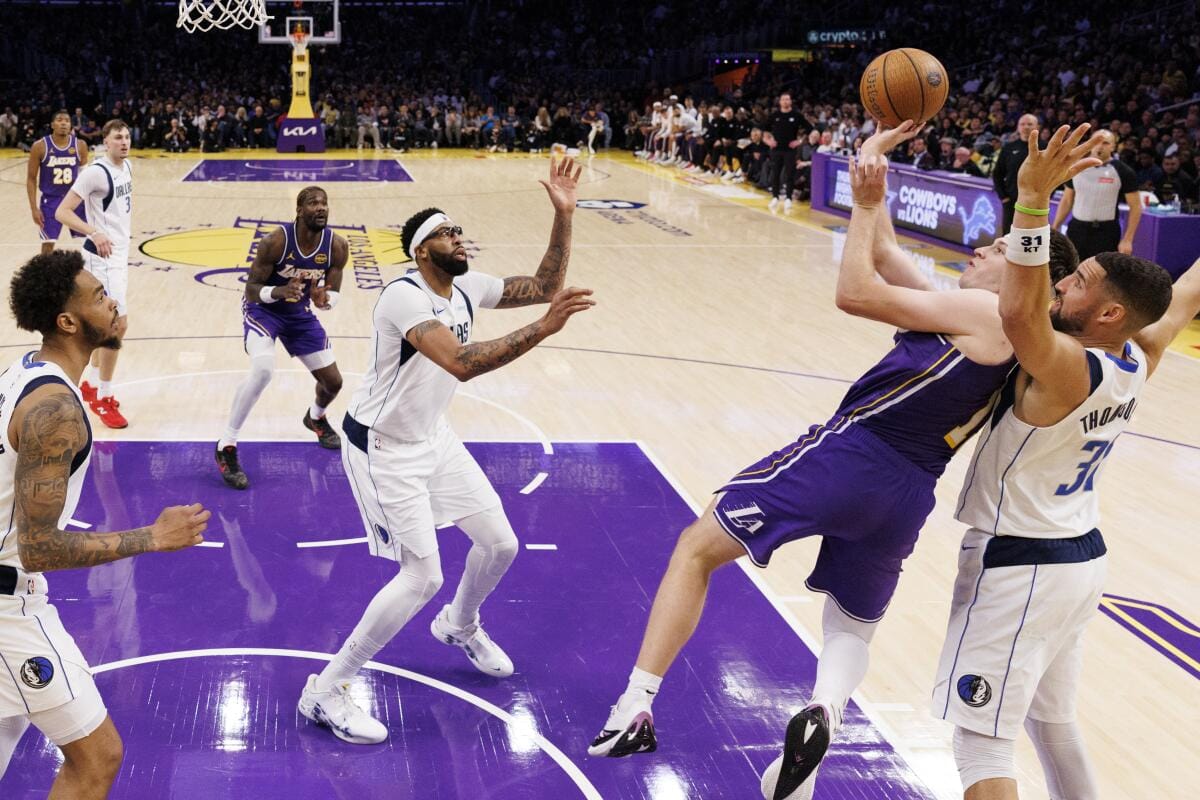Former Lakers star Anthony Davis makes long-awaited return to L.A.
The Lakers’ new big man went to the free throw line. The team’s former big man was on the mind of fans.
“I miss you, AD!” a Lakers fan shouted into the silence as Deandre Ayton prepared to shoot a free throw in the first quarter Friday.
Former Lakers star Anthony Davis played his first game in L.A. since being traded to the Mavericks last season, finishing with 12 points, five assists, five rebounds and three blocks in the Lakers’ 129-119 win at Crypto.com Arena.
The Lakers (14-4) won their sixth consecutive game and clinched West Group B in the NBA Cup, securing homecourt advantage for the tournament quarterfinals. The Lakers will host the San Antonio Spurs, who won West Group C, on Dec. 10 at 7 p.m.
The Mavericks (5-15) lost their third straight as the blockbuster trade that sent Luka Doncic to L.A. has only become more lopsided in the 10 months since it shocked the NBA.
Doncic had 35 points and 11 assists for the Lakers. Former Laker guard Max Christie, who was also involved in the trade, had 13 points and has become a regular starter for the Mavericks.
After two emotional matchups against his former team last year, Doncic said some of the feelings have subsided, but games against Dallas will always have special meaning for him.
Friday’s game was a well-timed return for Davis, who played in his first game after missing a month with a calf strain. The injury stretched for weeks as the Mavericks fell into the basement of the Western Conference.

LOS ANGELES, CA – NOVEMBER 28, 2025: Los Angeles Lakers guard Austin Reaves (15) scores two of his 38 points against Dallas Mavericks guard Klay Thompson (31) in the second half at Crypto.con Arena on November 28, 2025 in Los Angeles, California.(Gina Ferazzi / Los Angeles Times)
(Gina Ferazzi/Los Angeles Times)
Meanwhile, the Lakers have the second-best record in the West. Doncic leads the league in scoring with 35.1 points per game.
Doncic’s continued ascent to superstardom and Davis’ growing injury list has only made the trade more bitter for Mavericks fans. They got their form of revenge when former general manager Nico Harrison was fired on Nov. 11, but the change only signaled a new low for the franchise that went to the NBA Finals two short seasons ago.
Now the player who was supposed to help fill the void left by Doncic has been included in trade rumors. The Mavericks went 3-11 without Davis.
To ensure Davis stayed in a positive mental state during the time of turmoil for the franchise, Mavericks coach Jason Kidd encouraged him to simply stay focused on getting healthy.
“The train keeps moving,” Kidd said. “No matter of a trade or a dismissal, you got to keep moving. And so for AD, [it] was to focus on his body, come back healthy. … Can’t get everything solved in 24 minutes tonight, but as we go forward, we feel like we have a chance to win when he’s in uniform.”
Davis was on a 24- to 27-minute limit Friday. To adhere to the restriction, he had to leave the game with 6:56 left in the fourth quarter with the Mavericks down by just three points.
Leaving the court hurt, Davis said. He had gotten two blocks, an assist and a basket during the first five minutes of the fourth quarter, then the Lakers went on a 9-1 run after Davis went to the bench.
To Kidd, Davis is still one of the best in the world when he is healthy. The coach pointed to Davis’ impressive play in the Paris Olympics when he averaged 8.3 points, 6.7 rebounds and 1.5 blocks while shooting 62.5% from the field.
The Lakers didn’t need to be reminded of Davis’ talent. Coach JJ Redick said Davis would get the respect that all star players deserve because of his versatile skillset. But more than the shots he blocked or baskets he scored with the Lakers, Redick valued Davis for his support during Redick’s first year as a head coach.
“Very grateful that I had buy-in from him coming in Day 1 never had coached before,” Redick said. “So, it’s one of those things like you’re rooting for certain guys. … There are certain teammates you had, there’s always going to be guys that I coached [who] I either root for them after they are not your teammate and they are not one of your players. Just not when they play against us. Not tonight.”
The Lakers played a tribute video last year when Davis was sidelined with an abdominal injury for his first game back after the trade. Fans were showered him with cheers when he was introduced in the starting lineup Friday. LeBron James playfully bumped Davis at the center of the court before the game then they did the same intricate handshake they performed before games as teammates.

Lakers guard Luka Doncic puts up a jumper between Dallas Mavericks forward P.J. Washington and guard Max Christie on Friday at Crypto.com Arena.
(Gina Ferazzi/Los Angeles Times)
After the game, Lakers players lined up to hug Davis. Austin Reaves, who dominated with 38 points on 12 for 15 shooting with eight rebounds and three assists, gave him a two-armed bear hug. Davis grabbed the strap of his jersey and pointed toward Reaves.
“I always liked his game, what he was able to do,” Davis said. “Just now he’s doing it on a more consistent basis, putting up elite numbers. … He’s a player who I always knew could play to this level.”
Reaves left the Lakers locker room with Davis’ blue No. 3 jersey signed by his former teammate.
“He’s one of the best players to ever touch a basketball. I don’t know why he wanted my jersey,” Reaves said. “But for me to get his, it’s pretty fun. … From Day 1, he was telling me to be myself, don’t be anybody else. Continue to work and really be myself on the court. So I owe him a lot.”






